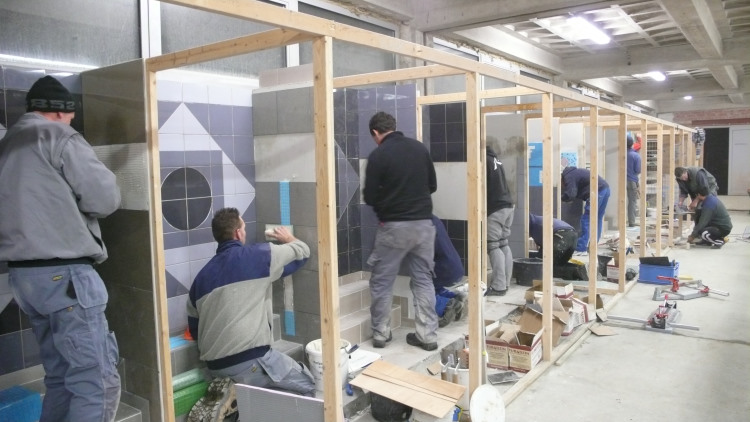How to lay tiles yourself?
By Staenis | | Manual
How to lay tiles yourself like a professional?
Planning to lay a tiled floor yourself in your kitchen, bathroom, or toilet? Then a handy step-by-step plan is always useful. That way, you won't overlook anything and the work will progress smoothly. Discover our tips and experience: installing ceramic floor tiles yourself is easier than you think! Especially with this introduction video included.
1. Ensure a good base
Laying a tile floor yourself requires a stable base. There are several possibilities. For example, you can lay tiles yourself on a screed floor, or you can tile over tiles (if there is already a tiled floor). So it is perfectly possible to tile over existing tiles, as long as you know how.
Are you going to lay tiles on a tiled floor? First sweep the tiled floor and vacuum it. Then thoroughly degrease the floor. This way you start with a dust- and grease-free surface. The perfect base for your tiled floor!
Good to know: If there is no screed yet in the room you want to tile, screeding must be done first. With the handy DIY system from Staenis, you can easily lay your screed yourself, whenever it suits you. You are guaranteed a flat and crack-free result, even if you have no experience! Watch the video and discover how it works.
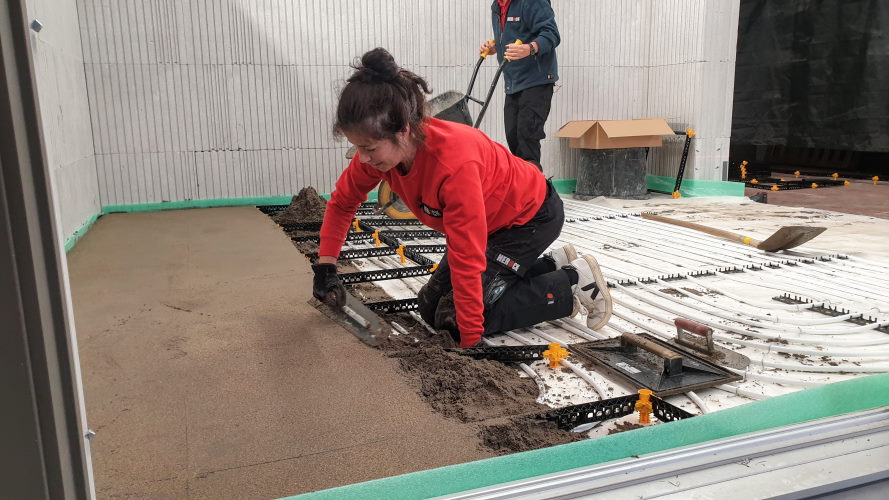
2. Prime the substrate
If you want to tile on a screed floor yourself, you must first apply a transparent porosity-regulating primer. This ensures that the tile adhesive you are going to use stays workable for longer. Handy, because who likes stress?
However, if you are going to tile over tiles, choose a transparent adhesion-improving primer for tiles. Such a 'tile over tile primer' improves the adhesion between the existing tiles and the tile adhesive.
Attention: do not use primer when installing a terrace floor or any other outdoor application. The primer will make the substrate partially waterproof, which can lead to problems.
3. Determine where the first tile should be placed.
Then it is time to determine where you will start tiling. Decide in advance where the first tile will be placed, and in which direction you will lay it. Check how large the tiles will be at the walls. Keep these cut tiles larger than 50%, as that looks better.
4. Prepare the tile adhesive
To lay tiles, you naturally need tile adhesive. To prepare your adhesive, use a tub and a mixer. Check the tile adhesive bag to see exactly how much water you need per bag. Use your measuring cup to measure the correct amount and pour the water into the tub with the tile adhesive. Mix the mixture for a few minutes. Then wait a few minutes and mix the mixture a second time.
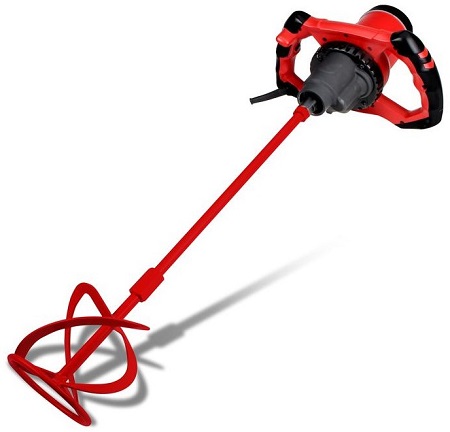
5. Cutting the tiles
To be able to place tiles nicely, they must have the correct dimensions. Some tiles will need to be cut. For cutting one straight line, use a tile cutter. To adjust a tile in different directions, use a grinder with a diamond saw blade.
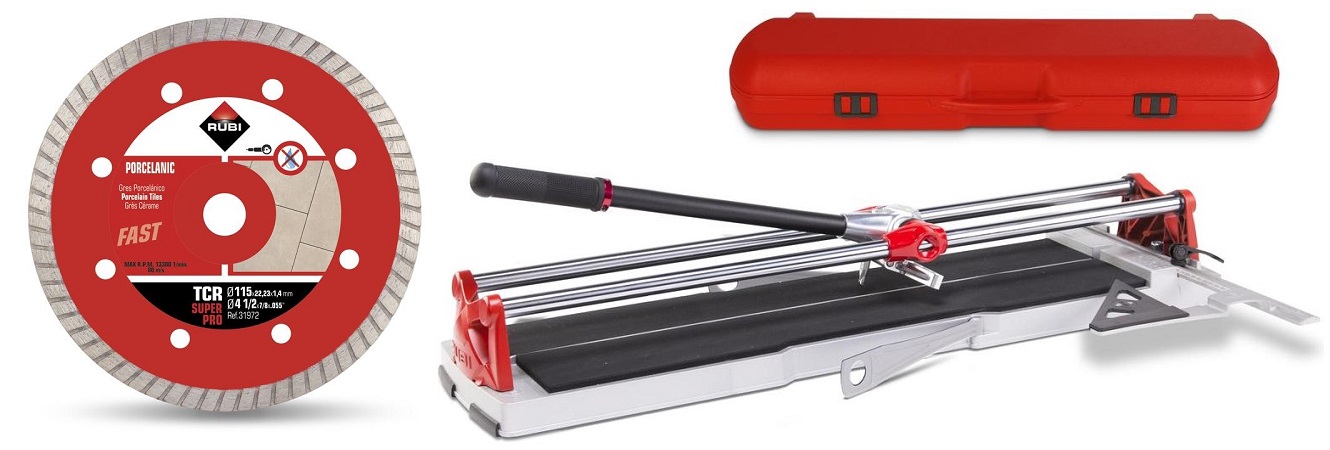
6. Gluing the subfloor
Which notched trowel is best to use for applying adhesive to the substrate? A 12 mm tile adhesive trowel is usually suitable for your job. It provides an adhesive height of 3 mm and a consumption of 6 kg/m². Adjust the tile adhesive trowel depending on the flatness of the substrate, the thickness of the tile, and the size of the tile. Grab your trowel and take a scoop of tile adhesive. Scrape the adhesive over the screed with the flat side of your notched trowel. This greatly improves adhesion. Then add more tile adhesive to the substrate. Hold the notched trowel at a 45-degree angle and make straight adhesive ridges.
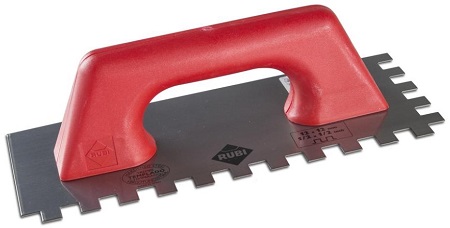
7. Gluing tiles in place
Gluing a tile is done as follows: take a scoop of tile adhesive with a trowel. Rub and scrape the adhesive over the back of the tile with the flat side of the notched trowel for good adhesion. Optionally, also apply adhesive ridges to the tile, parallel to those on the substrate. This allows you to increase the height if needed.
What thickness should the adhesive layer be that you apply to your floor tiles? For tile sizes smaller than or equal to 40 × 40 cm, the adhesive layer should be about 3 mm thick (single bonding). For tiles larger than 40 × 40 cm, choose a thickness of about 5 mm (double bonding). Large tiles usually require double bonding.
8. Laying tiles
Then it's time for the real work: laying the tiles. First, place the leveling clips under the previous tiles. It's best to lay a tile as follows: place the tile with one edge against the other tile and let the tile drop from about 10 cm height. This way, you remove most of the air between the substrate and the tile. This results in a fuller adhesion.
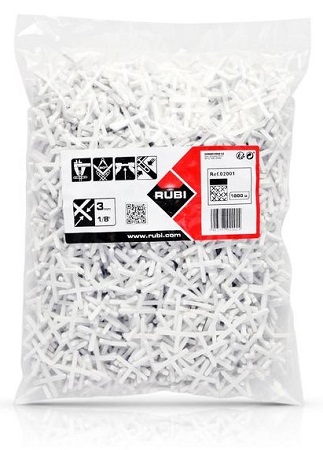
Then press the tile down with your hand until it is at the same height as the previous tiles. Follow the flatness of the surface while doing this.
Then place a 3 mm tile spacer between the two tiles. By paying attention to the tile spacer instead of the thickness of the clips, you can place the tiles more neatly. The tile spacers stay clean and ensure an even joint width. Remove excess adhesive from the joint with a sponge and a bucket of water.
Note: while tiling, check if the tile adhesive is still good to use. Test this by pressing your finger on the tile adhesive. If adhesive sticks to your finger, the adhesive is still okay and you may continue.
How can you remove traces of tile adhesive after tiling? In principle, all types of adhesive can be removed with mechanical means. With a hammer and chisel, or an electric hammer drill or router. Dispersion adhesives, however, are best removed with chemicals, such as paint remover, gall soap, or cement residue remover.
9. Installing a levelling or leveling system
Place the leveling or spacer wedges through the clips. Do this with the high side of the wedge against the last placed tile. First, try to work without the tensioning pliers. These pliers are only used to make the last millimeter perfectly even. The initial height difference between the tiles is corrected by pressing the tile down with your hands.
When finishing the tiling, place clips under the last tiles again so that you can use the leveling system again the next day.
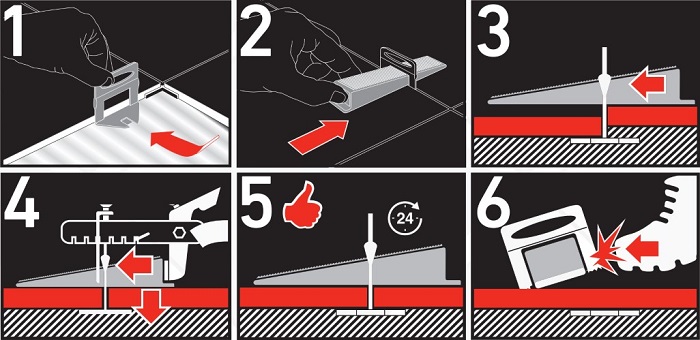
10. Remove clips and skewers
Kick or tap the clips loose sideways. Try to break off all the plastic from the clips. If that doesn't work, you can cut or scrape it out with a tool of your choice. Do not use a screwdriver for this, but a sharp utility knife. Cut at an angle to remove the excess plastic.
11. Grouting
Make sure all tile joints are clean. Then make the entire surface dust-free by mopping with water (without soap). Next, press the grout into the joints with a grout float. Try grouting small areas first; you can always make and apply more grout later. Finally, clean up excess grout with a sponge. Always follow the manufacturer's instructions.
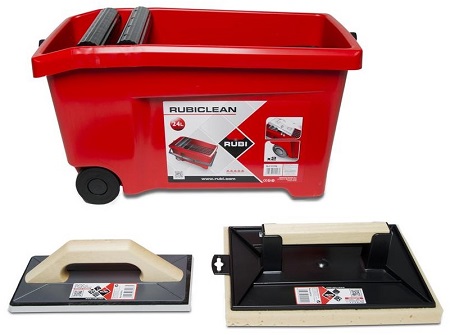
12. Installing skirting boards
Now you can start installing the tile skirting boards. To install a tile skirting board, use tile adhesive or (if necessary) silicone. Press the skirting board against the wall and use another tile to push it at a right angle, using the flatness of the floor. Place 2 tile spacers under the skirting board and position the skirting board neatly over the underlying tile. Fill the vertical joint with grout: the top with acrylic silicone and the bottom with sanitary silicone.
Attention: sometimes it may be necessary to chip off some plasterwork and reapply it with a cement-based mortar. This way, you avoid the risk of rising damp in your walls.
13. Finishing
Job done? Almost! Remove the remaining layer of dust from the tiles with water (without soap). Repeat this task until the tiles are clean. After a few weeks, you may use soap in the water to clean your tiled floor.
You now know how to lay tiles yourself like a true professional. For a durable result, always start with a level, solid base. With the help of the StaenisGrid, a handy leveling system, you can easily lay your perfectly flat and crack-free screed yourself. Installing, insulating, and leveling a screed with one system? It doesn't get any easier! Discover how it works.
